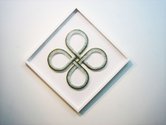John Hurrell – 20 November, 2009
Yet in her variety of regimented organisation Edwards is moving the fauna of these stamps towards an interesting purpose, especially when inventing new compositional formats.
Lianne Edwards is known for her meticulously assembled, floating grids of repeated used-stamp sections, hovering in mid air like the paper birds or butterflies she takes them from. Her practice has lots of similarities to Peter Madden’s except he uses magazine pages not stamps, likes to create sculpture with real depth, and fabricates even denser clusters of imagery. He is not interested in rigorously gridded order like Edwards with her shallow space, being more prone to chaotic forms motivated by global eco-politics.
Using Madden as a foil for discussion is useful because it makes us more aware of Edwards’ attraction to old used stamps, and what they contribute. Their colour for example, in conjunction with the white behind them, is delicate and restrained. Dark tones are rare – unlike say photos in magazines.
Edwards seems to be moving away from rectangular formations, and exploring other varieties of collage composition. Often she creates linear looping, figure-of-eight formations, or spirals or vortices. Each time with one motif relentlessly repeated obsessively.
Though the artist comes from a family of philately enthusiasts, it could be argued that she is a vandal cutting out sections of so many identical images - for the sake of Art. Yet in her variety of regimented organisation Edwards is moving the fauna of these stamps towards an interesting purpose, especially when inventing new compositional formats. In her art the stamps work best when they create a new counter-image that dominates over the initial tiny document. It transcends the material’s original context.
Some of these ‘stamp fields’ also create optical after-images, strange patterns of shape edge that materialise and then disappear in conjunction with the bright gallery light on the walls behind them. The white walls tend also to bleach the saturated stamp colour. The works operate as a form of op art.
Edwards I think is one of those artists who works by tinkering with an object or item, playing with it as a raw material (singly or in groups) to see what imaginative possibilities turn up; by mentally locking onto an item (perhaps by fetishising it by severing it from its function) and analysing its properties to discover new forms or meanings. Most artists in fact do it. They don’t start off with an idea or concept, they start by exploring a material or substance to see where it leads them.
Edwards’ challenge is to move away from the easily identifiable stamp grid, and to introduce further wit, like Michel Tuffery did a few years ago with his yellow bull made from corned beef cans. To let the newly created form take over to give the recycled raw material new life.
Recent Comments
Matt Wilson
I think this body of work is far more interesting than the work of Judy Millar who was chosen to ...






 Two Rooms presents a program of residencies and projects
Two Rooms presents a program of residencies and projects Advertising in this column
Advertising in this column



This Discussion has 1 comment.
Comment
Matt Wilson, 6:24 p.m. 20 November, 2009 #
I think this body of work is far more interesting than the work of Judy Millar who was chosen to represent New Zealand in Venice. Perhaps the committee ought to look at Robert Jahnke for the next Bienalle - it would be taking a small step backwards and a huge one forwards.
Participate
Register to Participate.
Sign in
Sign in to an existing account.